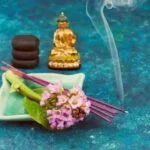Aromatherapy oils mixtures have garnered increasing popularity among individuals seeking natural remedies to enhance their well-being. These essential oils, derived from plants, possess a wide array of therapeutic benefits for the mind, body, and spirit. Whether used individually or blended together, aromatherapy oils can offer a holistic approach to improving one’s overall health.
The art of creating aromatherapy oil mixtures involves combining different essential oils to achieve specific desired effects. Each essential oil carries its own unique properties and aroma, making the possibilities for blending endless. From promoting relaxation and reducing stress to boosting focus and energy levels, the potential benefits of aromatherapy oils mixtures are vast.
In this comprehensive guide, we will delve into the world of aromatherapy oils mixtures, exploring how these potent plant extracts can positively impact our lives. By understanding the basics of aromatherapy oils and learning how to create personalized blends tailored to individual needs, anyone can harness the healing power of essential oils in their daily routine.
Benefits of Aromatherapy Oils Mixtures for Mind, Body, and Spirit
Aromatherapy oils mixtures offer a holistic approach to promoting well-being by harnessing the power of essential oils. These blends can provide a range of benefits for the mind, body, and spirit, making them a popular choice for those seeking natural remedies for various issues. Whether you are looking to reduce stress, improve sleep quality, boost focus, or enhance relaxation, aromatherapy oils mixtures can be customized to meet your specific needs.
Physical Benefits
Aromatherapy oils mixtures have been known to have physical benefits such as relieving pain, reducing inflammation, and boosting immunity. Essential oils like lavender, eucalyptus, and peppermint are commonly used in blends aimed at alleviating muscle aches, headaches, sinus congestion, and other physical discomforts. When used topically or inhaled through diffusion, these blends can help improve overall physical wellness and promote a sense of vitality.
Mental Benefits
The use of aromatherapy oils mixtures can also have significant mental benefits. Certain essential oils like citrus scents, rosemary, and frankincense are known for their ability to uplift mood, increase mental clarity, and reduce feelings of anxiety or depression. By incorporating these oils into your daily routine through diffusers or topical application (with proper dilution), you can experience improved cognitive function, enhanced focus, and a more positive outlook on life.
Spiritual Benefits
In addition to physical and mental benefits, aromatherapy oils mixtures can also contribute to spiritual well-being. Aromas like sandalwood, jasmine, and patchouli are often used in blends designed to promote relaxation, meditation practices or create sacred spaces for spiritual rituals.
These scents can help foster a sense of connection with oneself and the world around us while encouraging introspection and inner peace. Whether you seek to deepen your spiritual practice or simply enjoy moments of tranquility in your day-to-day life, incorporating aromatherapy oils mixtures into your routine can enrich your overall spiritual health.
Understanding the Basics
Aromatherapy oils, also known as essential oils, have been used for centuries for their therapeutic benefits. These concentrated plant extracts are derived from various parts of plants like flowers, leaves, bark, roots, and seeds.
Aromatherapy oils are believed to work through the olfactory system, which is connected to the brain’s limbic system – the part of the brain that controls emotions and memories. When inhaled or applied topically, aromatherapy oils can have a direct impact on our mood, emotions, and overall well-being.
To understand how aromatherapy oils work, it’s essential to know that each essential oil contains specific compounds that give them their unique properties. For example, lavender oil is known for its calming and relaxing effects due to its linalool content. On the other hand, peppermint oil is invigorating and refreshing because of its high menthol levels. These chemical constituents interact with the body in different ways when inhaled or absorbed through the skin.
When using aromatherapy oils mixtures, it’s important to consider their individual properties and synergistic effects when combined. Some essential oils complement each other well and create a harmonious blend with enhanced benefits. For instance, a blend of lavender, bergamot, and chamomile can promote relaxation and improve sleep quality.
Experimenting with different combinations of aromatherapy oils can help you discover potent mixtures tailored to your specific needs for holistic well-being. Below are some examples of popular essential oils used in aromatherapy oil mixtures:
- Lavender: Calming and soothing
- Peppermint: Uplifting and invigorating
- Eucalyptus: Respiratory support
- Tea Tree: Antimicrobial properties
By understanding the basics of how aromatherapy oils work and experimenting with various essential oil combinations, you can harness the power of nature to promote physical, mental, and emotional wellness in your daily life. Explore different blends to find what works best for you and enjoy the therapeutic benefits of aromatherapy oils mixtures.
Top Essential Oils for Aromatherapy Mixtures
When it comes to creating effective aromatherapy oil mixtures, choosing the right essential oils is key. Each essential oil carries its own unique set of benefits and properties, making some more suitable for specific needs than others. In this comprehensive guide, we will explore some of the top essential oils commonly used in aromatherapy mixtures and their therapeutic effects.
Lavender Oil
Lavender oil is perhaps one of the most popular essential oils used in aromatherapy due to its versatile nature. Known for its calming and relaxing properties, lavender oil is often used to promote better sleep, reduce stress and anxiety, and soothe headaches. It can be blended with other oils like bergamot or chamomile for a restful night’s sleep or mixed with peppermint for a refreshing aroma.
Peppermint Oil
Peppermint oil is renowned for its invigorating and refreshing scent, making it a popular choice for boosting energy levels and improving focus. It can also aid in relieving headaches, nausea, and muscle pain when applied topically or diffused. Peppermint oil blends well with citrus oils like lemon or orange for an uplifting aroma that can enhance mental clarity.
Tea Tree Oil
Tea tree oil is known for its powerful antimicrobial and antiseptic properties, making it a staple in natural remedies for skin conditions such as acne or fungal infections. When used in aromatherapy mixtures, tea tree oil can help purify the air and support respiratory health. It combines well with eucalyptus or rosemary oils to create a cleansing and revitalizing blend perfect for promoting wellness during cold and flu season.
By understanding the benefits of these top essential oils and learning how to blend them effectively, you can harness the power of aromatherapy oils mixtures to address various mind-body concerns and improve overall well-being in your daily life. Whether you are seeking relaxation, mental clarity, or immune support, experimenting with different combinations of essential oils can lead to personalized blends that cater to your specific needs.
The Art of Blending
Creating your own aromatherapy oil mixtures can be a fun and rewarding experience, allowing you to tailor the scents to your preferences and needs. Whether you are looking to relax, boost energy, or alleviate stress, blending essential oils can be a powerful tool in promoting overall well-being. Here are some tips and tricks to help you get started on crafting your own personalized aromatherapy oil mixtures:
- Start with a clear intention: Before you begin blending essential oils, think about the purpose or desired effect of your mixture. Are you looking to create a calming blend for relaxation, or do you need an energizing blend for focus and productivity? Having a clear intention will guide your selection of oils.
- Choose complementary scents: When blending aromatherapy oils, it’s important to choose scents that work well together and complement each other. For example, lavender is known for its relaxing properties, while peppermint is invigorating – combining these two oils can create a balanced blend for both relaxation and energy.
- Experiment with different ratios: The beauty of creating your own aromatherapy oil mixtures is that you can customize the strength and scent profile based on your preferences. Start by adding a few drops of each oil to see how they interact, then adjust the ratios until you find the perfect balance.
Once you have created your custom aromatherapy oil mixture, consider using it in various ways to enjoy its benefits. You can add a few drops to a diffuser for an uplifting aroma throughout your home, dilute it in a carrier oil for a soothing massage, or even create a room spray for instant relaxation. With practice and experimentation, you’ll discover the endless possibilities of aromatherapy oils mixtures in enhancing your daily life.
Precautions and Safety Measures When Using Aromatherapy Oils Mixtures
When using aromatherapy oils mixtures, it is important to take certain precautions and follow safety measures to ensure a positive and safe experience. Essential oils are highly concentrated plant extracts that can be potent and may cause adverse reactions if not used properly. Here are some key precautions to keep in mind when working with aromatherapy oils mixtures:
Firstly, it is essential to properly dilute essential oils before applying them to the skin. Most essential oils should not be applied directly to the skin without being diluted with a carrier oil. Not diluting essential oils can lead to skin irritation, sensitization, or other adverse reactions. Always follow recommended dilution ratios and patch test new blends on a small area of skin before using them extensively.
Another important precaution is to be mindful of any potential allergies or sensitivities you may have to specific essential oils. Some individuals may be allergic to certain plants or compounds found in essential oils, so it is crucial to research the ingredients of each oil in your mixture and proceed with caution if you have known allergies. If you experience any negative reactions such as itching, redness, or swelling, discontinue use immediately and seek medical advice if needed.
Additionally, it is crucial to store your aromatherapy oils mixtures properly to maintain their quality and potency. Essential oils are sensitive to light, heat, and air exposure, which can cause them to degrade over time. Store your oils in dark glass bottles away from direct sunlight and heat sources.
Keep them tightly sealed when not in use and avoid keeping them near open flames or heat-producing appliances. By taking these precautions and safety measures, you can enjoy the benefits of aromatherapy oils mixtures while minimizing the risk of adverse effects.
Aromatherapy Oils Mixtures for Different Needs
Aromatherapy oils mixtures have gained popularity for their therapeutic benefits in addressing various needs such as stress relief, improved sleep, enhanced focus, and more. Each essential oil brings its own unique properties and benefits to the blend, making them a versatile and effective tool in promoting holistic well-being.
For stress relief, certain aromatherapy oils mixtures such as lavender, chamomile, and ylang-ylang are known for their calming and relaxing properties. These oils help to reduce feelings of anxiety and tension, promoting a sense of calm and relaxation. When combined in the right proportions, these oils create a synergistic effect that can help alleviate stress and promote emotional balance.
Similarly, aromatherapy oils mixtures can also be tailored to address sleep issues. Essential oils like cedarwood, bergamot, and sandalwood are commonly used to promote relaxation and improve sleep quality. By blending these oils together, individuals can create a soothing aroma that helps induce restful sleep and combat insomnia. Whether diffused in the bedroom or applied topically before bedtime, these blends can have a profound impact on improving overall sleep patterns.
| Essential Oils | Benefit |
|---|---|
| Lavender | Calming and relaxing properties |
| Chamomile | Reduces anxiety and tension |
| Ylang-Ylang | Promotes emotional balance |
Ready-to-Use Aromatherapy Oil Mixtures
When it comes to aromatherapy oils mixtures, there are a plethora of ready-to-use options available on the market. These pre-blended essential oil combinations are convenient for those who may not have the time or knowledge to create their own blends.
Popular aromatherapy oil mixtures often target specific needs such as relaxation, stress relief, focus, and even respiratory support. Brands like doTERRA, Young Living, and Plant Therapy offer a wide range of pre-mixed essential oil blends that cater to various wellness goals.
One of the most popular ready-to-use aromatherapy oil mixtures is a blend designed to promote relaxation and alleviate stress. This mixture typically includes soothing essential oils like lavender, chamomile, and frankincense, known for their calming properties.
Another common blend focuses on boosting mental clarity and concentration, featuring invigorating oils such as peppermint, rosemary, and lemon. Whether you’re looking to unwind after a long day or enhance your productivity at work, there is a ready-made aromatherapy oil mixture for every occasion.
It’s important to note that while ready-to-use aromatherapy oil mixtures offer convenience and simplicity, some purists in the field of aromatherapy prefer creating their own custom blends. However, for those new to essential oils or seeking quick solutions, exploring popular pre-mixed options can be a great way to experience the benefits of aromatherapy without the hassle of blending multiple oils together.
Ultimately, whether you choose to purchase pre-made blends or experiment with creating your own mixtures, incorporating aromatherapy into your daily routine can have a positive impact on your overall well-being.
| Popular Ready-to-Use Aromatherapy Blends | Main Essential Oils Included |
|---|---|
| Relaxation & Stress Relief Blend | Lavender, Chamomile, Frankincense |
| Mental Clarity & Focus Blend | Peppermint, Rosemary, Lemon |
Conclusion
In conclusion, incorporating aromatherapy oils mixtures into your daily routine can truly enhance your overall well-being. The power of essential oils to soothe the mind, body, and spirit is something that has been utilized for centuries, and with good reason. By understanding the basics of aromatherapy oils and how they work, you can take full advantage of their benefits.
Whether you are looking to alleviate stress, improve sleep quality, boost focus, or achieve other specific needs, there is an essential oil blend out there for you. The art of blending different aromatherapy oils together is a creative and rewarding process. With the right tips and tricks in mind, you can create customized mixtures that cater to your individual preferences and goals.
Lastly, while using aromatherapy oils mixtures can be incredibly beneficial, it is important to always prioritize safety. Be sure to carefully follow precautions and guidelines when using essential oils topically or aromatically.
Additionally, exploring ready-to-use blends on the market can also be a convenient option for those who may not have the time or resources to create their own mixtures. Ultimately, embracing the healing power of aromatherapy oils mixtures in your daily routine can bring about a sense of balance, relaxation, and rejuvenation.
Frequently Asked Questions
Which Aromatherapy Oils Go Well Together?
Certain aromatherapy oils complement each other well when combined, creating a harmonious blend of scents and therapeutic benefits. For example, lavender and chamomile are often paired together for relaxation, while peppermint and eucalyptus create a refreshing and invigorating combination.
What Are Good Essential Oil Combinations?
Good essential oil combinations often depend on the desired effect or purpose of the blend. For promoting focus and concentration, a mix of rosemary and lemon can be effective. On the other hand, a calming bedtime blend could include cedarwood and bergamot to promote relaxation.
Which Essential Oils Can Be Mixed Together?
When mixing essential oils together, it’s important to consider their individual properties and effects. Oils from the same botanical family or with similar therapeutic benefits are generally safe to mix.
For example, citrus oils like sweet orange and bergamot can be combined for an uplifting aroma, while floral oils such as rose and geranium work well together for emotional balance.

Are you looking for a natural way to improve your health and wellbeing?
If so, aromatherapy may be the answer for you.





